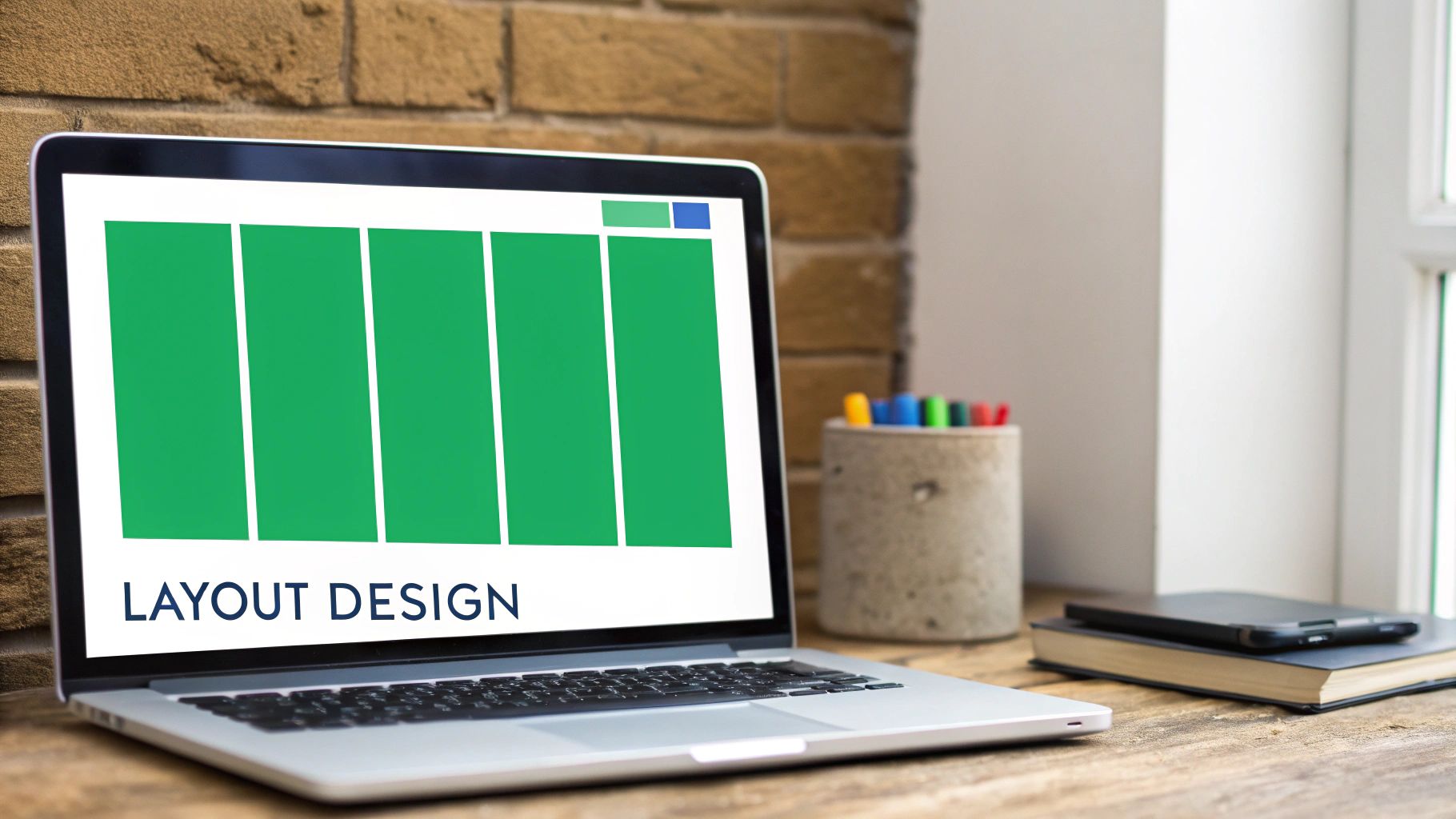Learn how to create sequence diagrams that clarify complex systems. Our guide covers use cases, tools, and advanced notation for developers and architects.
Before you can sketch out a sequence diagram, you need to know what it’s really for. Don’t think of it as just another technical diagram to check off your list. Instead, see it as a way to tell a story about your system. Each diagram zeroes in on one specific scenario—like a user logging in or an item being added to a cart—and shows, step-by-step, how different parts of the system talk to each other to make it happen.
The timeline moves from top to bottom, making the order of events crystal clear. It’s a powerful way to visualize the logic of a system in motion.
To really get the hang of creating these diagrams, you first have to understand the core components. They’re the basic vocabulary you’ll use to map out any system’s behavior.
Let’s look at a simple customer order process to see these pieces in action.

In this example, the diagram maps out the flow from the moment a customer places an order to when they get a dispatch confirmation. It’s simple, clean, and leaves no room for guessing what happens when.
Of course, a diagram is only as good as its clarity. That’s why it’s also helpful to keep broader technical writing best practices in mind. This helps ensure your diagrams aren’t just technically correct, but are actually easy for everyone to understand.
Getting comfortable with sequence diagrams means learning their visual language. This table is a quick-reference guide to the essential symbols and what they mean, so you can start decoding—and creating—diagrams with confidence.
Keep this cheat sheet handy. After you’ve drawn a few diagrams, these symbols will become second nature, allowing you to quickly sketch out complex interactions that everyone on your team can understand.

Alright, you’ve got the theory down. Now it’s time to get your hands dirty, and that starts with picking the right software. The tool you use for your sequence diagrams can be the difference between a smooth, efficient process and a frustrating bottleneck.
There’s a whole world of options out there, each with its own personality and strengths. The real question is, what do you need? Are you a lone developer trying to map out some logic on the fly? Or are you on a big, distributed team that lives and breathes by collaboration and version control?
For many, especially those who think visually, a good old drag-and-drop tool is the way to go. These are applications where you have a digital canvas to place your actors and objects, draw lifelines, and connect everything with messages using your mouse. It’s intuitive.
You’ve got a couple of flavors here:
Here’s where things get really interesting, especially for developers. A growing number of us are ditching the mouse and creating diagrams directly from plain text. This whole “diagrams as code” approach feels incredibly natural if you spend your day in a code editor.
Tools like PlantUML and Mermaid are champions in this space. You define your diagram’s components—actors, objects, messages—using a simple, human-readable syntax. The tool then does the magic of rendering the visual diagram for you. It’s lightning-fast once you get the hang of the syntax.
The killer feature? Version control. Because your diagram is just a text file, you can track every change with Git, just like the rest of your codebase. No more wondering who changed what or trying to merge clunky binary files.
So, which path should you take? Honestly, it all comes down to your team and your project. A fast-moving startup might gravitate toward the collaborative energy of a digital whiteboard. A bank or insurance company, on the other hand, will likely demand the rigorous standards of a dedicated UML tool.
Here’s a quick breakdown to help you decide:
Before you settle on a tool, think about how it will slot into your daily work. Does it play nice with Jira, Confluence, or your code editor? Answering that question will help you pick a solution that actually makes your life easier, not harder.
A great sequence diagram doesn’t start with a blank canvas. It starts with a clear purpose. From my experience, the most effective diagrams are grounded in a real-world scenario, usually one pulled directly from a user story or a functional requirement. This immediately ensures your diagram reflects actual system behavior, not just some abstract idea.
So, instead of jumping straight into drawing boxes and arrows, take a step back and deconstruct a specific task. Let’s use a classic e-commerce scenario: “As a registered user, I want to request a password reset so I can regain access to my account.” This simple statement is gold. It’s the perfect starting point for building a truly meaningful sequence diagram.
With that user story in hand, the first thing I always do is identify the key players. Who—or what—is actually involved in making this happen? For our password reset example, that cast of characters includes:
These components become the lifelines in your diagram. Listing them out first gives you a clear roster for the story you’re about to map out. This focus on practical needs is what separates a technically correct diagram from an incredibly useful one. It’s a key part of any solid agile product development process, where user stories are the lifeblood of the project.
This use-case-first approach is really a systematic way to tackle diagramming. Instead of guessing, you start by identifying concrete actions—like a user logging in or updating their profile—and then translate that narrative into a visual flow of interactions. Every step in the user’s journey simply becomes a message passed between your lifelines.
This infographic breaks down that translation process into a simple, repeatable flow.

The real takeaway here is that creating a good sequence diagram is a structured translation, not an act of spontaneous artistic genius.
Mapping these interactions forces you to think through the logic step-by-step, which is a fundamental part of technical design. In fact, learning how to document code properly often involves creating these kinds of clear, supporting visuals. By translating user needs into a visual sequence, your diagram becomes an invaluable tool for validating design choices and making sure everyone on the team is on the same page.

Simple message-passing is perfect for mapping out a system’s “happy path,” but let’s be honest—real-world systems are never that clean. They’re packed with conditional logic, loops, and all sorts of potential failure points. This is where a sequence diagram really shows its muscle, transforming from a basic flowchart into a serious piece of technical documentation.
To capture all that messiness, you need to get familiar with Interaction Fragments. Think of them as special boxes you draw on your diagram to frame specific sets of messages. They let you model advanced logic without turning your diagram into a tangled mess of arrows. Honestly, they’re the key to creating diagrams that actually reflect how things work in the real world.
One of the first hurdles you’ll hit is modeling “if-then-else” logic. For this, the **alt**** (alternative)** fragment is your best friend. It’s designed to show multiple possible outcomes that depend on a specific condition. A classic example is an e-commerce order: if the item is in stock, one set of messages fires off. If it’s out of stock, a completely different sequence gets triggered.
The alt fragment neatly separates these two paths with a dashed line, making the conditional logic crystal clear to anyone looking at the diagram.
There’s also a simpler version called the **opt**** (optional)** fragment. You’ll use this when a sequence of messages only happens if a certain condition is met—otherwise, the system just skips it. The “Apply Discount Code” interaction is a perfect use case. It’s optional; it only runs if the user actually enters a code.
What about things that need to happen over and over? That’s where the **loop** fragment comes in. You use it to enclose a sequence of messages that will execute multiple times. A great example is a system trying to reconnect to a payment gateway after a failed attempt. You can set the loop to run up to three times, with the condition (like “while retry count < 3”) noted right in the fragment’s corner.
In modern systems, especially those built on microservices, things often happen at the same time. The **par**** (parallel)** fragment is built for exactly this scenario. It shows two or more message sequences that execute concurrently. Imagine a user placing an order: the system might need to send a confirmation email and update the inventory database simultaneously. The par fragment shows that these actions don’t have to wait on each other.
Finally, you need a way to show when things go wrong and the whole process gets cut short. The **break** fragment handles these exceptional flows that terminate the interaction. If a payment gateway sends back a hard “Card Declined” error, the entire checkout process might just stop. By placing the error-handling messages inside a break fragment, you make it obvious that the normal flow is abandoned at that point.
Mastering these advanced fragments is what really levels up your diagramming skills. They let you move beyond simple sketches to create detailed, precise models that can guide development, help with debugging, and accurately document even the most complex system behaviors.
Think of sequence diagrams as more than just static blueprints you create during the design phase. They’re living documents, and honestly, they’re some of the most powerful tools you can have for troubleshooting and squeezing every last drop of performance out of a system.
When a system starts acting up, a good diagram is your roadmap. It helps you trace the root cause of a problem, turning a vague issue into a concrete, visual flow you can actually follow.
Imagine a user complaining about a request timing out. In a modern microservices architecture, that single request could be ricocheting between half a dozen different services. A sequence diagram lets your DevOps team trace its entire journey, message by message. This isn’t guesswork; it’s a methodical process that visually pinpoints exactly where a delay or failure is happening.
This same diagnostic power is a lifesaver in other complex areas, like data science. Today’s data pipelines can be incredibly intricate, weaving together multiple platforms and tools. In fact, a 2022 industry report found that 72% of organizations pointed to pipeline inefficiencies as a major reason for delays in making data-driven decisions.
Sequence diagrams cut through that complexity. They let you visually trace data as it moves through each stage—from an API extraction all the way to processing in an Apache Spark cluster. Suddenly, the bottlenecks slowing everything down become obvious. You can find a great breakdown of this in a report on sequence diagrams in data science.
What this really does is create a shared language between your development, QA, and operations teams. When everyone is looking at the same visual flow, conversations about performance become far more productive. The diagram stops being a static picture and becomes a dynamic tool for solving problems together.
A sequence diagram acts as an objective, single source of truth that closes communication gaps.
Instead of developers and QA engineers trying to describe a problem with words, they can just point to a specific message or interaction on the diagram. This shared understanding is absolutely critical for resolving issues quickly.
For example, when a bug crops up, the QA team can annotate the sequence diagram to show exactly where the system’s actual behavior deviates from what was expected. This gives developers immediate context and dramatically cuts down on the time they’d otherwise spend just trying to replicate the issue. The diagram becomes the central piece of evidence that guides the entire team’s debugging process. This kind of clarity is also a core principle of great technical documentation, a topic we dive deep into in our ultimate guide to API documentation generation tools.
Once you get the hang of the basics, you’ll start running into those tricky, real-world questions about sequence diagrams. These are the kinds of practical problems that pop up on complex projects, and knowing how to handle them is what separates a novice from an expert.
One of the first questions I always get is, “How much detail is too much?” Honestly, the answer comes down to your audience and what you’re trying to achieve. If you’re in a high-level meeting with product managers, you want a clean, simple diagram that just shows the main interactions. But if you’re a developer trying to squash a specific bug, that same diagram might need to show every single self-message and return value to be useful.
Striking this balance is a huge part of effective technical communication. In fact, if you’re comfortable with the principles of good code documentation, you’ll find it much easier to decide on the right level of detail in your diagrams. For a deeper dive, our comprehensive guide on what is code documentation provides some great context that applies here, too.
This is a classic point of confusion. While both are ways to visualize a process, they spotlight completely different things. A flowchart is all about decision logic—the classic “if this, then that” flow. It’s perfect for mapping out the steps and choices inside a single process or component.
A sequence diagram, on the other hand, is built to show time and interaction. Its whole purpose is to illustrate how different objects or components talk to each other over a specific period. That vertical layout is a timeline, making it the best tool for untangling the sequence of messages flying around in a system.
Absolutely. You pretty much have to these days, since so many modern systems are event-driven. Sequence diagrams have specific notation just for this.
Using the right arrow is critical for an accurate diagram, especially when you’re working with distributed architectures where tons of interactions are asynchronous to avoid blocking the whole system.
Fragments like alt, loop, and opt are incredibly powerful, but it’s easy to go overboard and clutter your diagram. My rule of thumb is to only use them when the logic they contain is essential for understanding the main scenario you’re trying to explain.
For example, if an inventory check is a core part of your “Place Order” sequence, an alt fragment showing both “in stock” and “out of stock” paths is probably necessary. But if you’re trying to model a minor, tangential error state, you’re better off creating a separate diagram for that edge case. This keeps your primary “happy path” diagram clean, simple, and easy to read.
Ready to stop manually drawing diagrams and start automating your documentation? With DocuWriter.ai, you can generate clear, accurate UML diagrams directly from your codebase. Spend less time drawing and more time building. Explore our AI-powered documentation tools today.